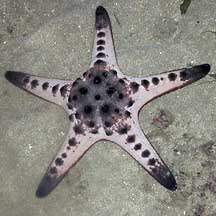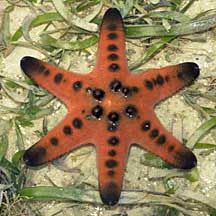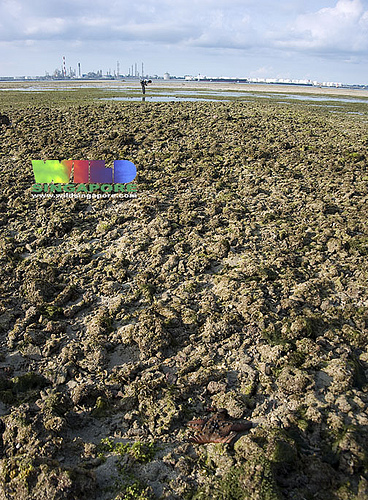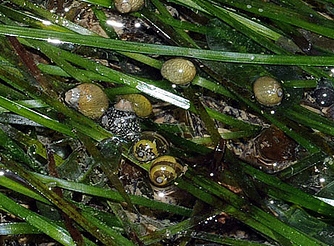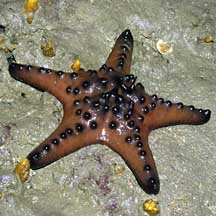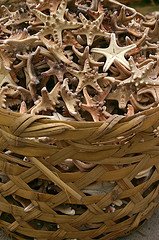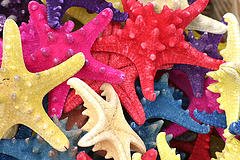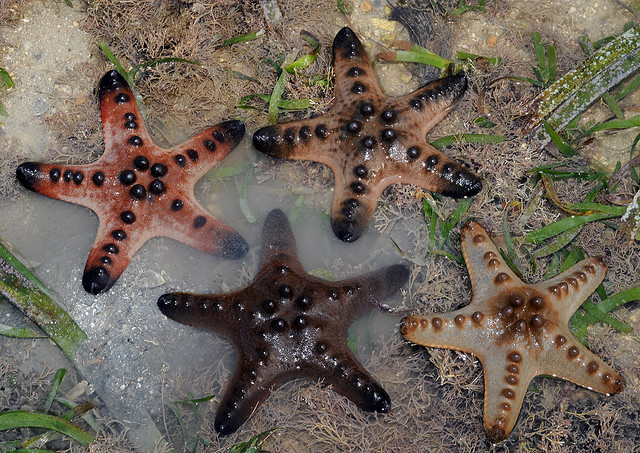 |
| Photo by: Ria Tan www.wildsingapore.com |
Common names
Knobbly Sea Star, Chocolate Chip Sea Star, Horned Sea Star, Rhinocerous Sea Star
Biology
Feeding habitsThe Knobbly sea star feeds on microbial and microalgal films and detritus associated with the sediment surface, sea grasses or macroalgae (Scheibling & Metaxas, 2008).
Opportunistic feeding on gastropods, sponges, soft corals, and other small invertebrates has also been observed by Schoppe (2000)
[5]. Food is digested extraorally by everting its cardiac stomach upon the substratum (Scheibling & Metaxas, 2008).
(See video below).
Note: This video shows the general feeding behaviour of sea starsSpecies shown in video is not the Knobbly sea star.
The larva of this species are planktotrophic (Scheibling & Metaxas, 2008), feeding on plankton during the larval stage for development and metamorphosis to the juvenile stage (McEdward, 1997).
Reproduction
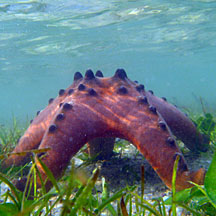 |
| Spawning posture of Protoreaster nodosus. Photo by: Ria Tan |
When spawning, female Knobbly sea stars have been observed to be elevated on their ray tips in an arched posture similar to females of Oreaster reticulatus(another sea star in the same family (Scheibling & Metaxas, 2008).
. Unlike other sea stars, spawning aggregations have not been observed in P. nodosus. Instead, they are randomly distributed and when experimentlally aggregated by Scheibling & Metaxas (2008), they rapidly returned to pre-manipulation density. This may reflect a compromise between minimizing intraspecific competition for food and maximizing fertilization success.
Spawning period:March to May at full moon (Scheibling & Metaxas, 2008, Bos et al, 2008).
Defense
How do the Knobbly sea star escape predation if they are unable to move fast?
Physical: Knobbly sea stars manage this by having massive and ornate cardinal spines as well as a robust and heavily calcified body that serves as defences against any enemy (Scheibling & Metaxas, 2008).
Chemical: They also produce a type of organic chemical known as saponins, found in their body wall, which makes them taste unpleasant and toxic to many predators (Minale et. al, 1982).
back to top ^
Distribution
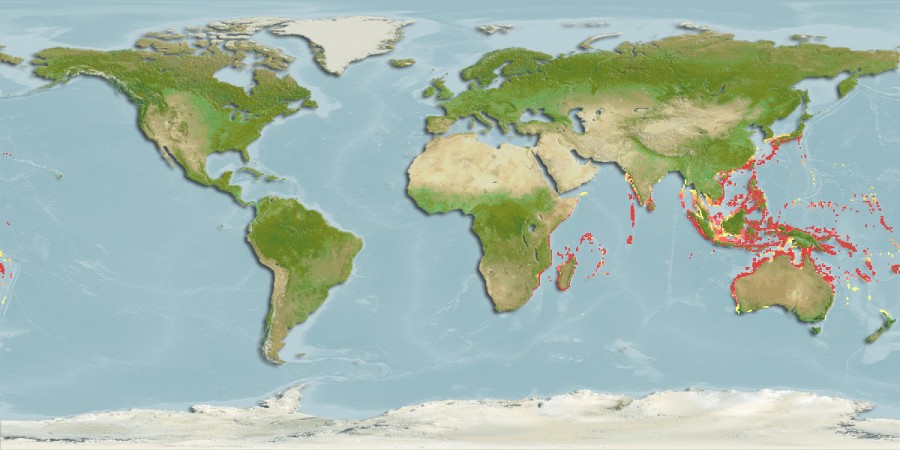
This species has a broad geographic distribution in the western tropical Pacific and Indian Ocean, ranging from the Seychelles to Australia and Japan to southernmost China, and can be found in depths from 1 to 30 m (Clark H.L., 1946, Clark and Rowe, 1971).
It has been previously recorded as common or abundant in Palau, New Caledonia, the Philippines, and Madagascar (Scheibling & Metaxas, 2008).
back to top ^
Description
- How to identify a Knobbly sea star?
Juvenile
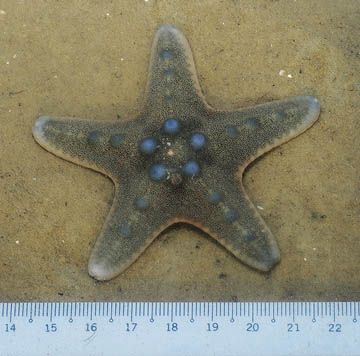 |
| Photo by: Ria Tan |
Similar to adult, but with-mottled colouration-radius of less than 12 cm (Scheibling & Metaxas, 2008).
Juveniles attain reproductive maturity at an estimated age of 2 to 3 years (Bos et al, 2008).
Adult
|
|
|
|
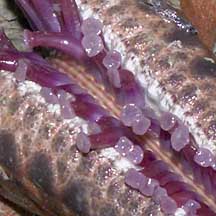 |
| Tube feet. Photo by: Ria Tan |
Color:Various shades ranging from orange, red, brown and beige to bluish-brown (Ng et al, 2011).
Tube feet: Dark red or purple in colour (What are tube feet?)
Body: Robust, heavily calcified body.
Large, darkly pigmented nodules (tubercles) on its dorsal surface, with evenly tapering arms. The nodules are scattered irregularly on the central disk, but aligned in a series along the mid-line of each arm (Lane and Vandenspiegel 2003)
.
Size:Most adults reach a radius of approximately 15 cm (Schoppe, 2000) but some have been observed up to 20 cm in radius (Clark H.L., 1946).
The knobbly sea star are dioecious (have separate sexes), but the males and females cannot be distinguished without dissection. Female gonads are orange/yellow, male gonads are creamy white (Bos et al, 2008). The two sexes occur in the ratio 1:1 (Bos et al, 2008).
Each and every Knobbly is DIFFERENT!
Each individual Knobbly sea star has a unique number and arrangement of knobs on the dorsal surface that can be used to distinguish two sea stars apart. This allows them to be monitored without the use of any invasive method (Chew, 1993). Learn more about how to identify and track them here!
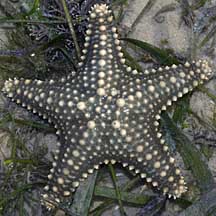 |
| Photo by: Ria Tan |
Is this a Knobbly?
The Pentaceraster sea star (Pentaceraster mammilatus) has also been observed on the shores of Singapore. However, the presence of knobs should not fool you into believing it is a Knobbly sea star. The Knobbly sea star can be distinguished by a single row of knobs on the upperside of the arms unlike the Pentaceraster sea star. Learn more about the Pentaceraster sea star here!
back to top ^
Habitat
| Coral rubble |
Seagrass beds |
Sandy bottoms |
||||||
|
|
|
back to top ^
skip to Ecology
Do YOU know?
-Interesting facts about sea stars in general#1 Sea star or Starfish?
 |
| Sea stars have no backbone! |
 |
| Fishes are vertebrates! |
#2 Sea stars can move too!
Sea stars have rows of tube feet found in the grooves on their underside, which they control using a water vascular system . Tube feet helps sea stars to latch on to a surface, move slowly across the substrate, and even flip themselves over!
Watch the video below to see how they use their tube feet to get back to an upright position.
#3 Sea stars have eyes too!
They are known as eye spots and are found at the tips of each arm. Unlike our eyes, they cannot see details and only contain light sensitive pigments to detect shadows and changes in brightness of light.
#4 Sea stars have two stomachs!
The cardiac stomach can be everted out of its body to engulf its prey and digest it externally. This stomach is then brought back inside its body, where the partially digested food is moved to the second stomach- the pyloric stomach, for further digestion. Due to its ability to digest food outside it's body, the cardiac stomach allows a sea star to prey on animals larger than its mouth!
back to top ^
Ecology
Role in the enviromentThe Knobbly sea star invests a great portion of its time in feeding and foraging (Scheibling & Metaxas, 2008). By continuously reworking surface sediments and digesting living and detrital particulate organic material in sand and seagrass habitats, they may exert an important top-down control on the microbial and meiofaunal communities and thus play an important ecological role in their habitat (Scheibling & Metaxas, 2008).
.
Predators
This species was found to be preyed upon by the gastropod Charonia tritonis (Thomassin, 1976). Fishes such as the pufferfish and triggerfish are also likely predators as fish-bite scars have been observed on the smooth papular areas of their oral surface (Scheibling & Metaxas, 2008, Ng et al, 2011).
.
Commensalism / Host
The Knobbly sea star provides a habitat to a number of commensals, including scale worms, shrimps and crabs and plays host to several parasitic molluscs
(Coleman, 2007).
back to top ^
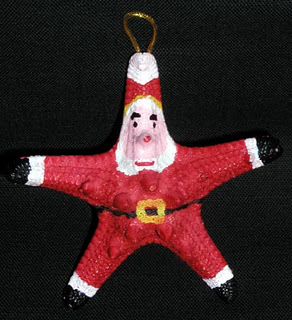
Dried specimen of the Knobbly sea star painted as a christmas tree ornament Photo by: Christopher Mah
Threats to the Knobbly sea star
The Knobbly sea star is extensively harvested as an ornamental decorative for the marine curios trade as well as the aquarium trade. In countries where they are abundant, they are frequently encountered in shallow water habitats and are easily collected. They are then left out in the sun to be air dried and sold in souvenir shops. As they are a slow growing species (Bos et al, 2008), such overharvesting may lower fertilization rates of populations such that the species cannot persist locally.
The next time you visit such places, DO NOT be tempted to buy them back as souvenirs!
.
The Knobbly sea star is also popular as pets in aquariums. However, these sea stars are hard to keep in captivity and often die after awhile due to stress and starvation. Learn more about it here!
Please RECONSIDER if you are thinking of getting one as a pet!
The loss or deterioriation of shallow coastal habitat due to human activities may also limit recruitment to populations of Knobbly sea stars (Bos et al, 2008). This is especially so for the seagrass meadows that serve as nursery areas for juveniles.
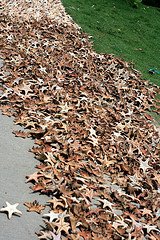 Thousands of Knobbly sea stars harvested from their natural habitat and left out to dry Thousands of Knobbly sea stars harvested from their natural habitat and left out to dry |
|
The Knobbly sea star in Singapore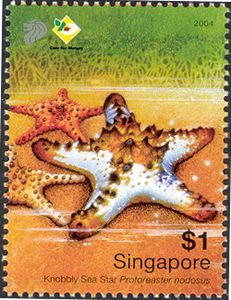
The Knobbly sea star is featured in a stamp as one of the wonders found in Chek Jawa. Photo from: http://www.singpost.com/

National Status: Endangered (EN) under the Singapore Red Data Book 2008.
The Knobbly sea star is uncommon in Singapore waters except at isolated locations on reef flats in the Southern Islands (Pulau Semakau, Pulau Sekudu and Cyrene reef) and Chek Jawa (Ng et al, 2011, Davison et al.,2008).In Singapore, it is vulnerable to potential mutilation or disturbance by reef walkers and to habitat loss during reclamation (Davison et al.,2008). The knobbly sea star is also threatened by unusually heavy rainfalls such as the one over southern Johor in December 2006 and January 2007, which led to excessive amounts of freshwater runoff and a drop in salinity that caused a mass mortality of many benthic organisms, including the knobbly sea star (Ng et al, 2011).
Watch this video to see a Knobbly sea star in the seagrass beds of Cyrene reef!
Beautiful Cyrene 1 - knobbly star at sunrise from SgBeachBum on Vimeo.
back to top ^
Taxonavigation
-This allows identification of biological groupings of the sea starKingdom: Animalia
Phylum: Echinodermata
Class: Asteroidea
Order: Valvatida
Family: Oreasteridae
Genus: Protoreaster
back to top ^
Taxonomic history
Protoreaster nodosus is an accepted name (WoRMS)Earliest name of the species as designated by Linnaeus in the 10th edition of Systema Naturae: Asterias nodosa (Linnaeus, 1758)
.
Etymology
- What is the origin of the name?
The species epithet nodosus, refers the nodules found on the dorsal surface of the sea star.
.
Synonymised taxa
- In taxonomy, a synonym is a scientific name that arises when the same taxa is named more than once independently or during a change in exisiting taxa (e.g. when two genera are merged to become one). Only ONE scientific name is considered to be the correct one at any one time. The other inappropriate ones become the synonyms of the same species.
Oreaster nodosus Bell, 1884. (One of the more commonly used synonym in past literature)
Other synonymised taxa can be found here.
back to top ^
Type Information
- A type is one particular specimen or a group of specimens of an organism to which the scientific name is formally attached to. It should have all or most of its diagnosable characters and may be referred upon if there are any uncertainties, such as when revising the genus or species name or determining if another new species is found..
Status and whereabouts for the holotype of Asterias nodosa (Linnaeus, 1758) remains undetermined.
Other specimens can be found at the Raffles Museum of Biodiversity Research in Singapore, Museum Victoria and Smithsonian Natural Museum of Natural History
back to top ^
Diagnosis
- A diagnosis helps to correctly identify one species from another.
Protoreaster nodosus can be differentiated from P. nodulosus by it size. The radius of full grown P. nodulosusdoes not exceed 16cm whereas full grown P. nodosus have a radius of up to 20cm (Clark H.L., 1946). The absence of red in the colouration of P. nodulosusis another conspicuous difference between the two species (Clark H.L., 1946).
back to top ^
Links to other webpages
- Find out more information regarding the Knobbly sea star, Protoreaster nodosus.Wild Singapore
World Register of Marine Speces
Encyclopedia of Life
Project Semakau
Wikipedia
GenBank
back to top ^
Literature and References
Scheibling, R. E., and Metaxas,A.,(2008) Abundance, Spatial Distribution, and Size Structure of the Sea Star Protoreaster nodosus in Palau, with Notes on Feeding and Reproduction. Bulletin Of Marine Science, 82(2): 221–235.
Bos, A. R., Gumanao ,G. S., Alipoyo, J. C. E., Cardona,L.T. (2008). Population dynamics, reproduction and growth of the Indo-Pacific horned sea star, Protoreaster nodosus (Echinodermata; Asteroidea).Marine Biology 156(1): 55-63.
Ng, P. K. L., Corlett R. T., Tan, H. T. W. (2011). Singapore Biodiversity: An Encyclopedia of the Natural Environment, Natl Book Network.
Lane, D. J. W. and Vandenspiegel, D., (2003). A guide to sea stars and other echinoderms of Singapore. Singapore Science Centre, p. 64-65.
Schoppe, S. (2000). A guide to the common shallow water sea stars, brittle stars, sea urchins, sea cucumbers and feather stars (Echinoderms) of the Philippines. VISCA-GTZ Applied Tropical Ecology Program, Visayas State College of Agriculture, Baybay, Leyte, Philippines and Times Editions Singapore, 144 p.
Clark, H.L., (1946). The Echinoderm Fauna Of Australia, its composition and its origin. Carnegie Institution of Washington. Publication 566. Pp105-106.
Chew, T. C., (1993). Individual recognition and digestive anatomy of Protoreaster nodosus (L. 1758) (Echinodermata: Asteriodea). BSc Honors thesis, National University of Singapore.
Thomassin, B. A. (1976). Feeding behaviour of the felt-, sponge-, and coral-feeder sea stars, mainly Culcita schmideliana
McEdward, L. R. (1997). Reproductive Strategies of Marine Benthic Invertebrates Revisited- Facultative Feeding by Planktotrophic Larvae. The American Naturalist 150(1): 48-72
Coleman, N., (2007). Sea stars: echinoderms of the Asia/Indo-Pacific. Neville Coleman's Underwater Geographic Pty Ltd.
Davison, G. W. H., Ng, P. K. L., & Ho, H. C. (Eds.). (2008). The Singapore red data book: Threatened plants & animals of Singapore. Singapore: Nature Society (Singapore).
Clark AM, Rowe (1971) Monograph of shallow-water Indo-West Pacific echinoderms. No. 690. British Museum (Nat. Hist.), London
L. Minale , C. Pizza, R. Riccio And F. Zollo, (1982). Steroidal Glycosides From Starfishes Pure & Appl.Chem. ,J., Vol.54, No.10, Pp.L935—I950.
back to top ^
Comments
Please feel free to comment or share any additional relevant information on the Knobbly sea star, Protoreaster nodosus. To comment, click on the 'Discussion' tab at the top of the page.
| Subject | Author | Replies | Views | Last Message |
|---|---|---|---|---|
| No Comments | ||||
back to top ^
